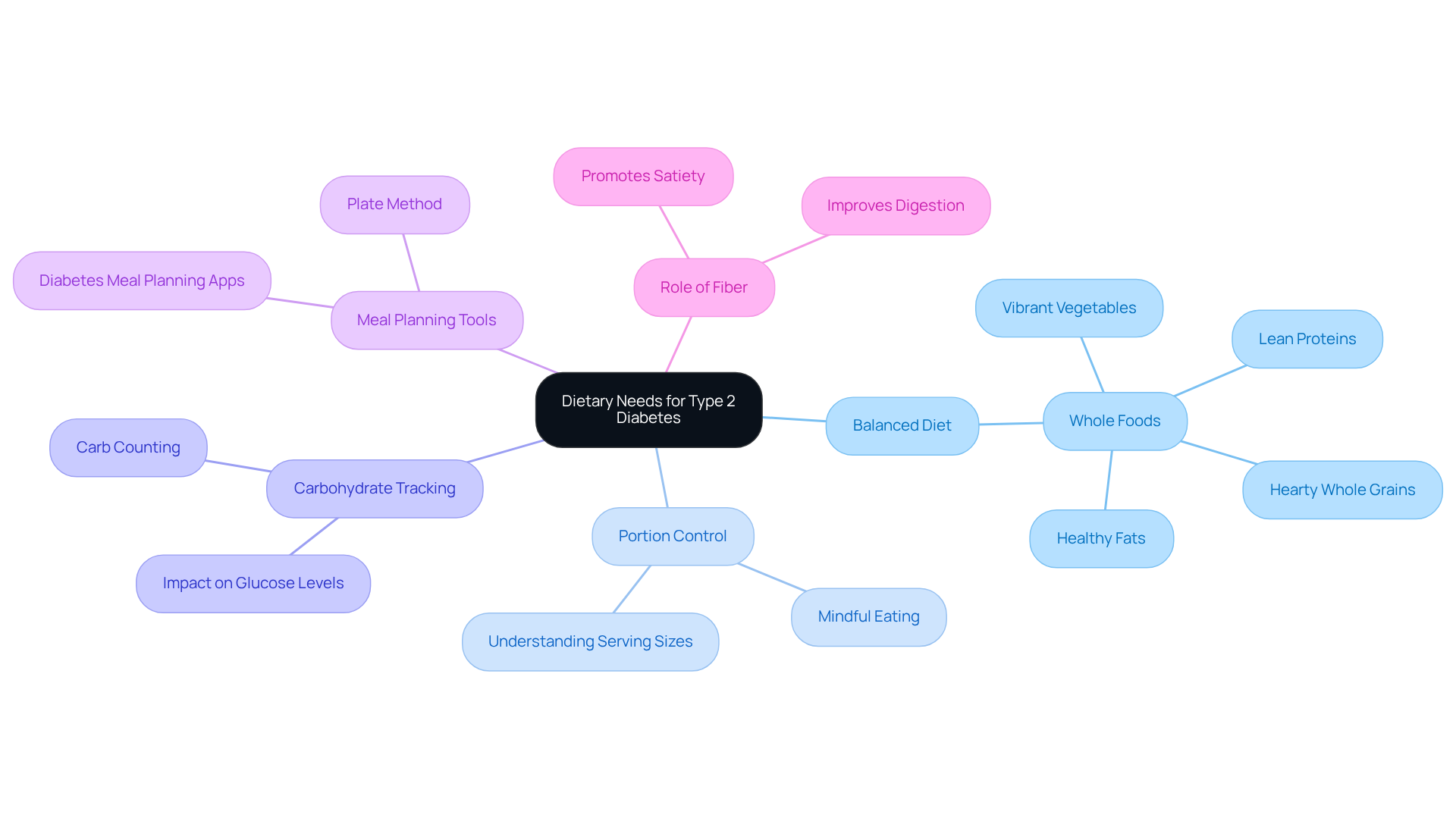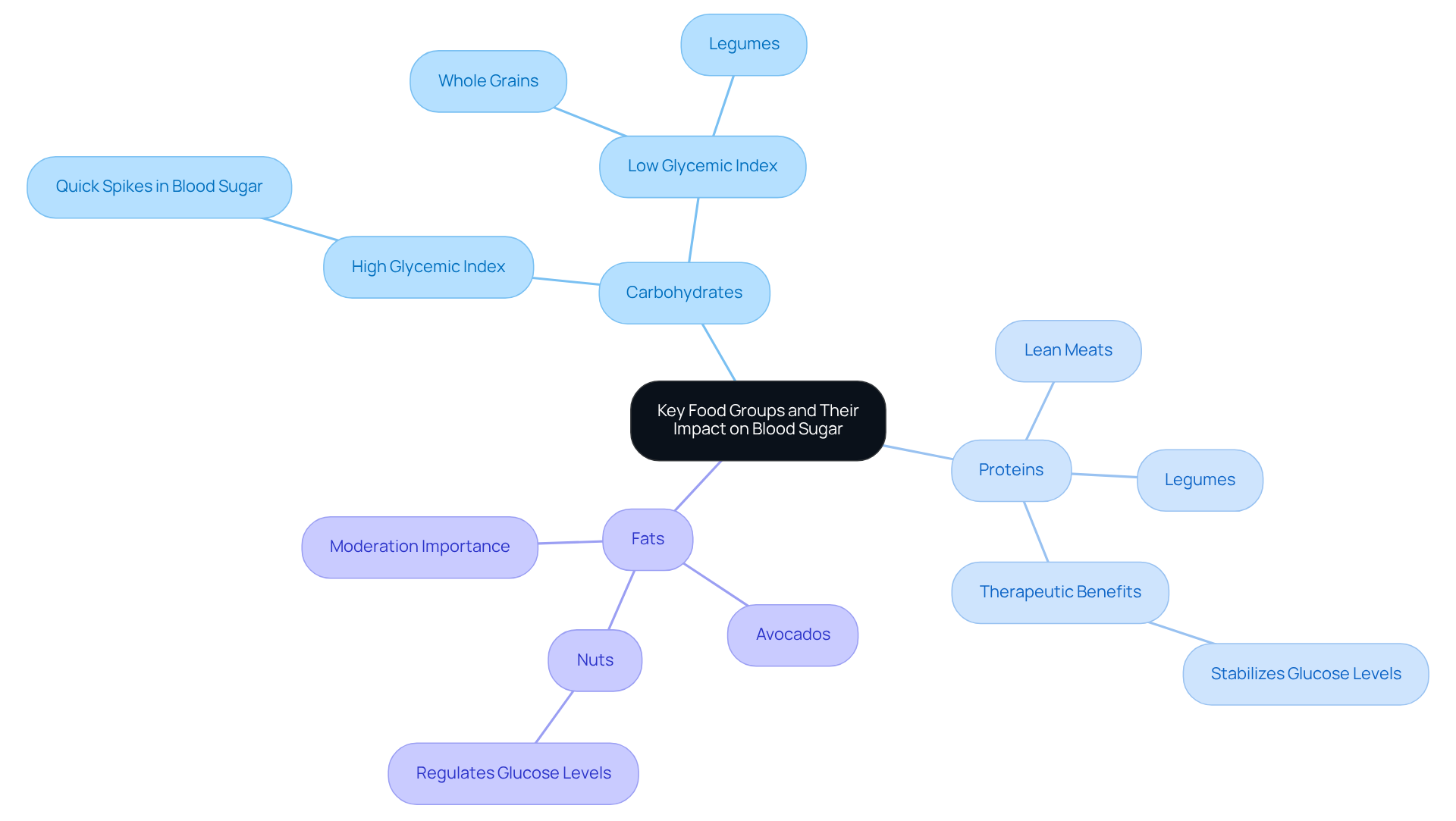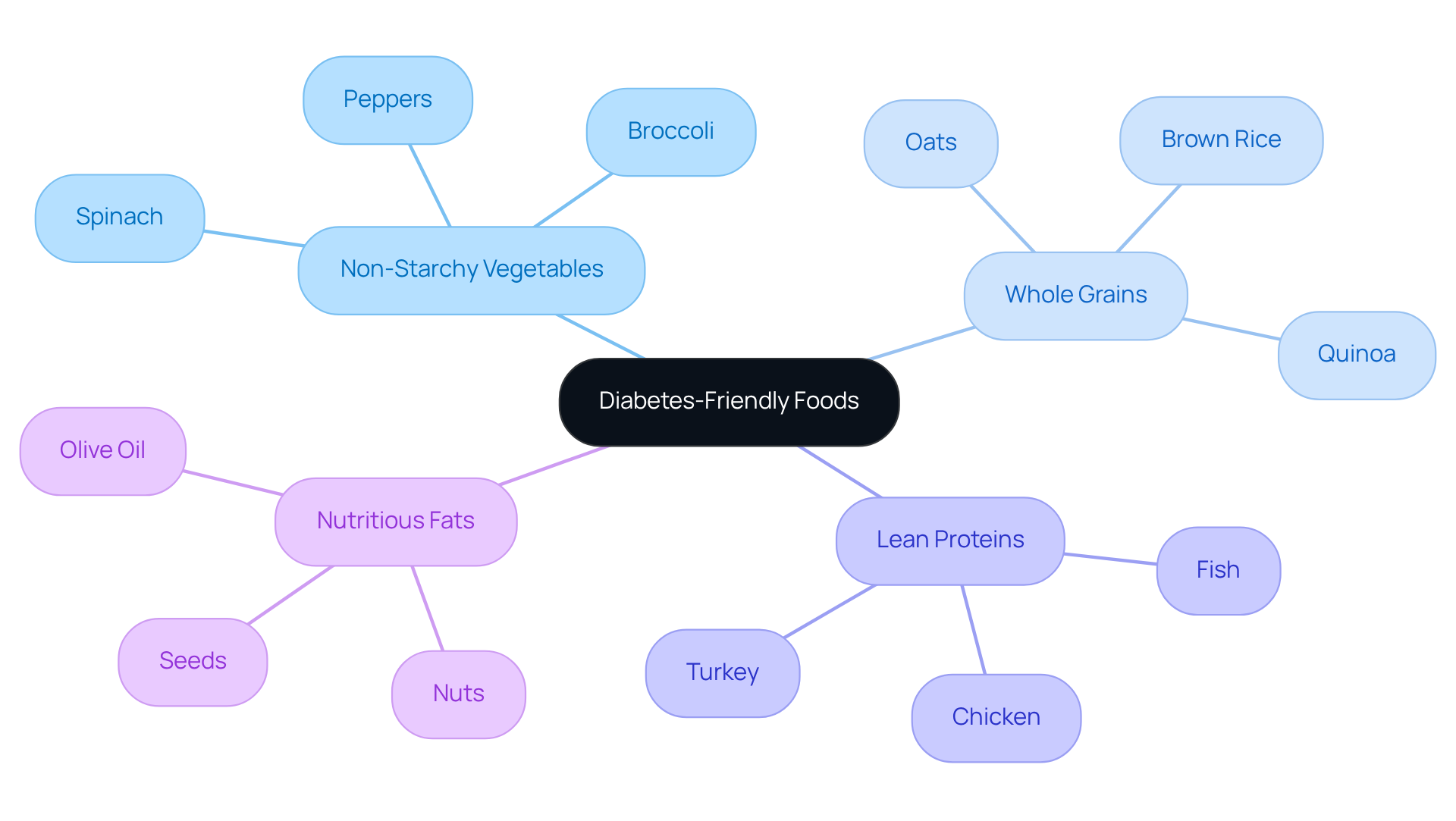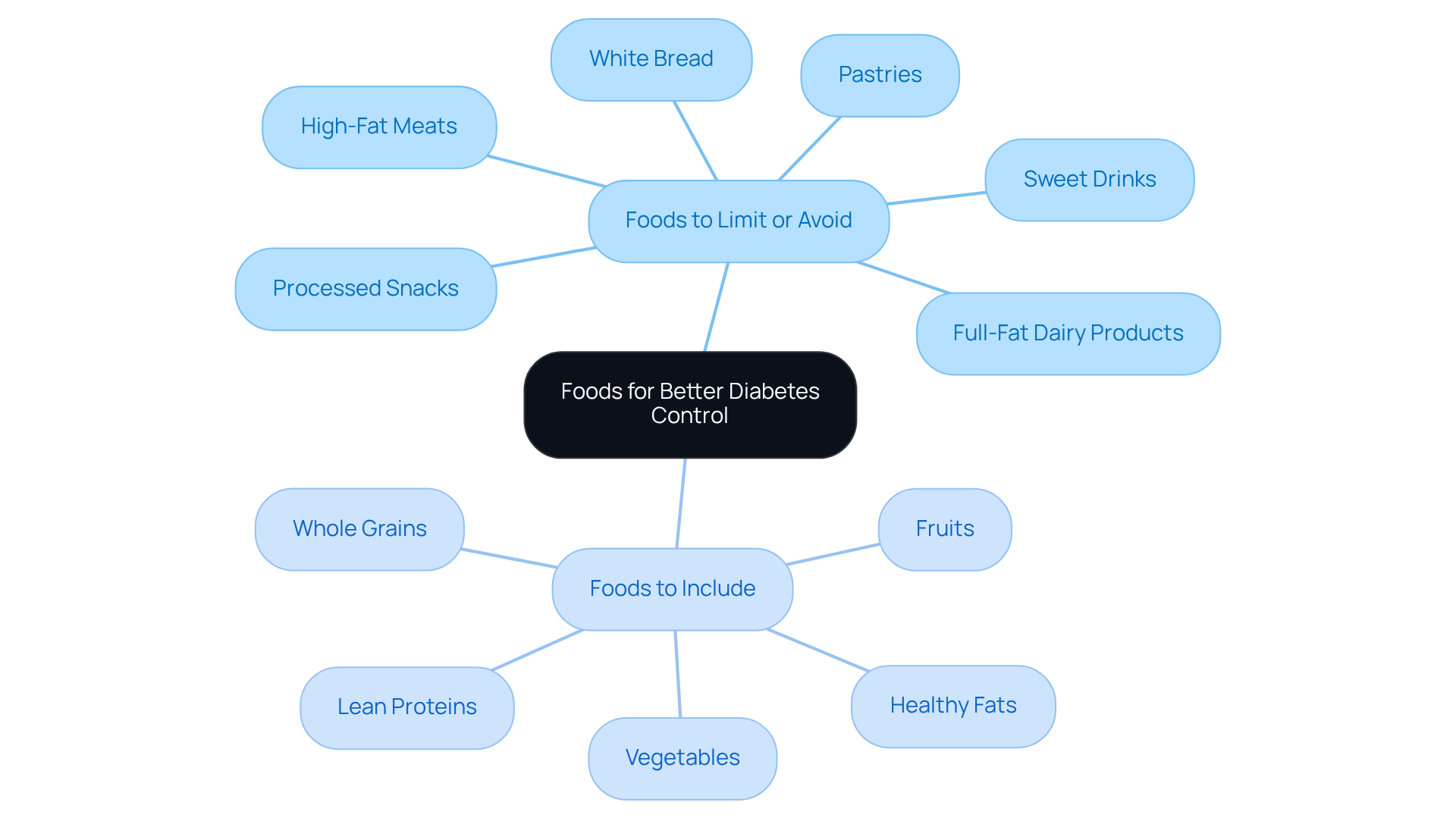Overview
This article is dedicated to helping individuals with Type 2 Diabetes find the right foods to support their health journey. A balanced diet, rich in whole foods such as vegetables, whole grains, lean proteins, and healthy fats, is essential. These food choices play a crucial role in stabilizing glucose levels, managing weight, and enhancing overall well-being.
It's understandable to feel overwhelmed by dietary changes, but knowing which foods to embrace can make a significant difference. By focusing on whole foods, you can create a nourishing environment for your body. Additionally, it's important to be aware of certain foods that should be limited or avoided to prevent spikes in blood sugar.
Remember, you're not alone in this journey. Many have walked this path and found success through informed choices. We encourage you to explore resources and support options available to you. Together, we can navigate this journey toward better health.
Introduction
Understanding the dietary landscape for individuals with Type 2 Diabetes is crucial for effective management of this condition. It's understandable to feel overwhelmed by the complexities of food choices, but with the right knowledge, you can navigate this journey to maintain stable glucose levels and promote overall health. The question remains: what foods truly support this journey, and which should be avoided to prevent spikes in blood sugar? This article delves into essential food groups, practical meal ideas, and critical dietary strategies that empower you to make informed decisions. Remember, you're not alone in this journey; we are here to support you every step of the way.
Understanding Dietary Needs for Type 2 Diabetes
Managing Type 2 Diabetes can feel overwhelming, but you're not alone in this journey. A balanced diet is essential for controlling sugar levels, and knowing what foods can you eat with type 2 diabetes is a vital step toward effective dietary management. Practicing portion control is equally important. Embrace a diet rich in whole foods, such as vibrant vegetables, hearty whole grains, lean proteins, and healthy fats, by understanding what foods can you eat with type 2 diabetes. These choices not only promote overall health but also illustrate what foods can you eat with type 2 diabetes to help stabilize glucose levels.
Tracking carbohydrates is particularly crucial for determining what foods can you eat with type 2 diabetes, as these macronutrients significantly impact glucose levels. Nutritionists emphasize that a balanced diet, which includes understanding what foods can you eat with type 2 diabetes, not only aids in glucose management but also enhances overall well-being. Remember, fiber plays a significant role in managing diabetes by improving digestion and promoting satiety, which can help you understand what foods can you eat with type 2 diabetes for effective weight management.
Utilizing diabetes meal planning tools, such as the plate method and carb counting, can help determine what foods can you eat with type 2 diabetes while providing practical strategies for maintaining balanced meals. It's understandable to feel uncertain about these changes, but as Dr. Dinesh Kacha notes, addressing dietary habits through mindful eating can significantly impact insulin resistance and metabolic health. By prioritizing a balanced diet and incorporating these strategies, you can achieve better health outcomes and improve your quality of life. We are here to support you every step of the way.

Key Food Groups and Their Impact on Blood Sugar
Essential nutrient categories include carbohydrates, proteins, and fats, each playing a vital role in managing glucose levels. Carbohydrates, especially those with a high glycemic index, can lead to quick spikes in blood sugar, which can be concerning. However, low-glycemic foods like whole grains and legumes offer a more gradual increase, supporting your journey toward stability. For instance, the estimated average intake of total carbohydrates ranges from about 130 to 340 grams, a crucial aspect for anyone managing diabetes.
Proteins, such as lean meats and legumes, help stabilize glucose levels by slowing down digestion. Dr. Jelena Kolic emphasizes that diets rich in protein may provide therapeutic benefits for individuals with Type 2 diabetes, reinforcing their importance in a balanced diet. Nutritious fats, found in avocados and nuts, contribute to feelings of fullness and can also assist in regulating glucose levels when consumed in moderation. Interestingly, 8% of donor cells showed greater responsiveness to fats than any other nutrient, highlighting their significant role in diabetes management.
Understanding these impacts is essential for effective diabetes management. By focusing on low-glycemic options and incorporating adequate protein and healthy fats into your meals, you can discover what foods can you eat with type 2 diabetes to improve glucose regulation and enhance your overall quality of life. Remember, you're not alone in this journey. As John Landry reminds us, embracing hope and positivity is vital as you navigate this path. We are here to support you every step of the way.

Examples of Diabetes-Friendly Foods and Meal Ideas
Managing Type 2 Diabetes can feel overwhelming, but understanding what foods can you eat with type 2 diabetes and incorporating those diabetes-friendly foods into your meals can make a significant difference. Non-starchy vegetables like spinach, broccoli, and peppers are not only low in calories but also packed with essential nutrients. They are perfect for any meal and can help you feel your best.
Whole grains, such as quinoa, brown rice, and oats, serve as excellent sources of carbohydrates. They provide fiber that plays a vital role in regulating glucose levels. Lean proteins, including chicken, turkey, and fish, are essential for maintaining muscle and keeping you satisfied throughout the day. Adding nutritious fats from sources like olive oil, nuts, and seeds not only enhances flavor but also supports stable glucose levels.
For practical meal ideas, consider what foods can you eat with type 2 diabetes, including:
- A quinoa salad filled with vibrant mixed vegetables
- Grilled chicken paired with steamed broccoli
- A nourishing breakfast of oatmeal topped with fresh berries and a sprinkle of nuts
These selections not only assist in glucose regulation but also contribute to your overall health and wellness. Remember, you’re not alone in this journey; we are here to support you every step of the way.

Foods to Limit or Avoid for Better Diabetes Control
For individuals managing Type 2 Diabetes, knowing what foods can you eat with type 2 diabetes is crucial to limit or avoid foods high in added sweeteners, refined carbohydrates, and unhealthy fats. Sweet drinks, white bread, pastries, and processed snacks can cause rapid spikes in glucose levels. Research indicates that excessive intake of added sweeteners is significantly associated with an increased risk of diabetes. This underscores the importance of making mindful dietary choices. Additionally, high-fat meats and full-fat dairy products should be consumed sparingly, as their saturated fat content can worsen insulin resistance.
Instead, focusing on whole, minimally processed foods can lead to improved sugar regulation and overall well-being. To understand what foods can you eat with type 2 diabetes, it is recommended to follow a diet rich in fruits, vegetables, whole grains, and lean proteins, as these foods provide essential nutrients without causing drastic fluctuations in blood glucose. For instance, individuals who have adopted a Flexitarian diet—emphasizing plant-based foods while allowing for occasional meat—have reported lower A1c levels and better weight management.
Being mindful of nutrition labels and portion sizes is a vital strategy for effective diabetes management. With more than 50 different terms for sweeteners found in food products, understanding nutrition labels can empower individuals to make informed decisions. By embracing these dietary changes, many have seen significant improvements in their diabetes management, highlighting the importance of nutrition in controlling blood sugar levels.
Moreover, T2DSolutions serves as a valuable resource hub, offering education and community support to help individuals navigate their dietary choices and enhance their overall well-being. Remember, you’re not alone in this journey; we are here to support you every step of the way.

Conclusion
Understanding what foods can be consumed with Type 2 Diabetes is crucial for effective management and improved health outcomes. By focusing on a balanced diet rich in whole foods, you can take significant steps towards stabilizing your blood sugar levels. It's important to emphasize mindful eating and making informed dietary choices, empowering you on this journey to embrace a healthier lifestyle.
Key dietary strategies include:
- Prioritizing low-glycemic carbohydrates
- Lean proteins
- Healthy fats
- Limiting processed foods and added sugars
Foods such as non-starchy vegetables, whole grains, and lean meats not only support glucose regulation but also enhance your overall well-being. Utilizing meal planning tools and being aware of nutrition labels are essential practices for maintaining a balanced diet that aligns with your nutritional needs.
Ultimately, your journey towards managing Type 2 Diabetes can be navigated successfully with the right knowledge and support. By adopting a proactive approach to your dietary choices, you can significantly improve your quality of life and health outcomes. Embrace these dietary changes, stay informed, and seek community support. Remember, you're not alone in this journey—together, we can foster a healthier future.
Frequently Asked Questions
Why is a balanced diet important for managing Type 2 Diabetes?
A balanced diet is essential for controlling sugar levels and is a vital step toward effective dietary management for Type 2 Diabetes.
What types of foods should be included in a diet for Type 2 Diabetes?
A diet rich in whole foods, such as vibrant vegetables, hearty whole grains, lean proteins, and healthy fats, is recommended to promote overall health and stabilize glucose levels.
Why is it important to track carbohydrates for Type 2 Diabetes?
Tracking carbohydrates is crucial because these macronutrients significantly impact glucose levels, making it important for effective dietary management.
How does fiber contribute to managing Type 2 Diabetes?
Fiber plays a significant role by improving digestion and promoting satiety, which can aid in effective weight management for individuals with Type 2 Diabetes.
What meal planning tools can help manage Type 2 Diabetes?
Tools such as the plate method and carb counting can help determine appropriate food choices and provide practical strategies for maintaining balanced meals.
What is the significance of mindful eating in managing Type 2 Diabetes?
Mindful eating can significantly impact insulin resistance and metabolic health, helping individuals make better dietary choices.
How can individuals achieve better health outcomes with dietary changes?
By prioritizing a balanced diet and incorporating strategies like portion control and carbohydrate tracking, individuals can improve their health outcomes and quality of life.



